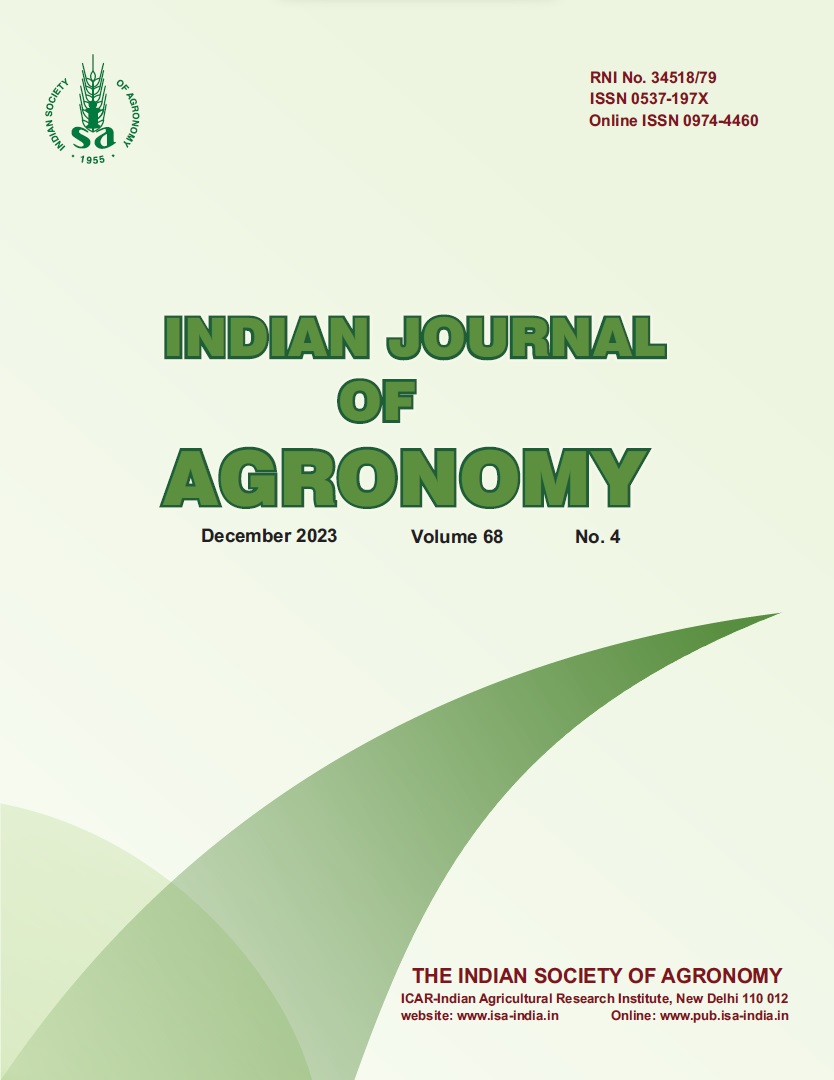Effect of conjoint application schedules of organic and inorganic sources of nutrients on growth, yield and economics of rice
DOI:
https://doi.org/10.59797/ija.v68i4.5453Keywords:
Economics, growth parameters, rice, Integrated, yieldAbstract
A field experiment was conducted during (kharif) summer season of 2019 and 2020 at Crop Research Centre, Sardar Vallabh Bhai Patel University of Agriculture and Technology, Modipuram, Meerut, Uttar Pradesh to study the effect of integrated use of chemical nitrogen fertilizer and green manure on performance of rice (Oryza sativa L.). The experiment consists of fourteen treatment combinations of conjoint application of organic and inorganic sources of nutrients was laid-out in randomized block design with three replications. The results showed that the significant highest dry matter accumulation (1,205.90 g/m2 ) at harvest stage, leaf-area index (4.18), crop growth rate (16.34 g/m2 /day), relative growth rate (7.09 mg/g/day), grain yield (3.88 t/ha) and straw yield (6.64 t/ha) recorded in the 25% recommended N through dhaincha incorporated + 75% N through chemical fertilizer was found at par with RDF (120N : 60P : 50K) and 25% recommended N through vermicompost incorporated 10 days before transplanting + 75% N through chemical fertilizer and it was significantly superior over rest of the treatment combinations. The substitution of 25% N through incorporated dhaincha at planting was found most promising in terms of productivity, profitability and performed better than other treatments and may be recommended for farmers of Uttar Pradesh and similar agro-eco regions.
References
Anonymous. 2017. Annual report 2017–18. Department of Agriculture Cooperation and Farmers Welfare, Government of India, p. 208.
Bana, R.S., Pooniya, V., Choudhary, A.K., Rana, K.S. and Tyagi, V.K. 2016. Influence of organic nutrient sources and moisture management on productivity, bio-fortification and soil health in pearlmillet (Pennisetum glaucum) + clusterbean (Cyamopsis tetragonoloba) intercropping system of semiarid India. Indian Journal of Agricultural Sciences 86(11): 1,418–1,425
Birhanu. 2017. Response of common bean (Phaseolus vulgaris L.) varieties to blended nitrogen, phosphorus and sulfur fertilizer rates at Areka, southern Ethiopia, Wolaita Sodo University, Ethiopia, M.Sc. Thesis.View at: Google Scholar.
Black, C.A. 1967. Soil Plant Relationship, 2nd Edn., 515—516. John Wiley & Sons Inc., New York.
Blackman, V. H. 1919. The compound interest law and plant growth. Annals of Botany 33(131): 353–360.
Carriger, S., and Vallée, D. 2007. More crop per drop. Rice Today 6(2): 10–13.
Choudhary, A.K. and Suri, V.K. 2014. Integrated nutrient management technology for direct-seeded upland rice (Oryza sativa) in northwestern Himalayas. Communications in Soil Science and Plant Analysis 45(6): 777–784.
FAO. 2017. The treatment of agriculture in regional trade agreements. Trable policy briefs 29. FAO support to the WTO negotiations at the 11th Ministerial Conference in Buenos Aires. www.fao.org/3/a-i8010e.pdf.
Jat, M.L., Chaplot, P.C., Bairwa, D.D., Meena, S.N. and Dhayal B.C. 2021. Effects of integrated nutrient management on yield andeconomics of barley (Hordeum vulgare). Indian Journal of Agronomy 66(4): 425–429.
Kumari, N., Pal, S.K., Barla, S. and Singh, C.S. 2014. Impact of organic nutrient management on dry matter partitioning, growth and productivity of scented rice. Oryza 51(1): 48–54.
Paul, J., Choudhary, A.K., Suri, V.K., Sharma, A.K., Kumar, V. and Shobhna. 2014. Bioresource nutrient recycling and its relationship with bio fertility indicators of soil health and nutrient dynamics in rice-wheat cropping system. Communications in Soil Science and Plant Analysis 45(7): 912–924.
Pooniya, V., Shivay, Y. S., Rana, A., Nain, L. and Prasanna, R. 2012. Enhancing soil nutrient dynamics and productivity of Basmati rice through residue incorporation and zinc fertilization. European Journal of Agronomy 41: 28–37.
Sharma, G.D., Thakur, Risikesh, Chouhan, Narendra and Keram, K.S. 2015. Effect of Integrated nutrient management onyield, nutrient uptake, protein content, soil fertility and eco-nomic performance of rice (Oryza sativa L.) in a Vertisol. Journal of Indian Society of Soil Science 63(3): 320–326.
Sherma, N., Shukla, Y.R. Singh, K. and Mehta, D.K. 2020. Soil fertility Nutrient Uptake and Yield & BELLPEPPER AS influenced by conjoint applicational organic and inorganic fertilizers. Communications in Soil Science and Plant Analysis, 51(12): 1626–1640.
Thakur, Risikesh, Shrivastava, A.K., Sarvade, S., Rai, S.K., Koutu, G.K., Bisen, N.K. and Khan, M.I. 2021. Response of integrated application of inorganic fertilizersand vermicompost on rice productivity at farmer field. International Journal of Plant and Soil Science 33(4): 25–31.
Watson, D.J. 1952. The physiological basis of variation in yield. Advances in Agronomy (4): 101–145.
Wang, F., Li, Q., He, C., Liu, C., You, Y.; Huang, Y. 2021. Combined return of rice straw and organic fertilizer to yellowmud paddy soil to improve the rice productivity and substitute chemical fertilizers. Chinese Journal of Eco-Agriculture 29: 2,024–2,033.






